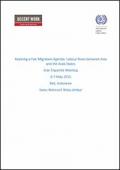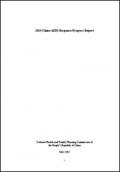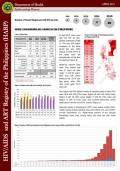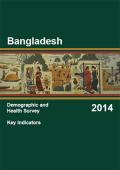What's New
Displaying results 3021 - 3030 of 4922

Resource | Publications,
UNAIDS welcomes additional evidence released in May 2015 that early initiation of antiretroviral therapy has a positive effect on the health and well-being of people living with HIV. The United States National Institutes of Health-funded international randomized clinical trial START (Strategic Timing of Antiretroviral Treatment) has found compelling evidence that the benefits of starting antiretroviral therapy as soon as someone is diagnosed outweigh the risks of delaying until their CD4 count has fallen to 350 cells/mm3.

Resource | Publications,
The Ministry of Health’s 2014 statistics on HIV and AIDS show a slight increase of 3,517 HIV cases from 3,393 in 2013 to 3,517 new cases with a total cumulative of 105,189 HIV cases. The trend indicates a 78 per cent increase in sexual relations comprising homo/bisexuals and heterosexuals.
While women and girls continue to be susceptible to HIV infection and experience HIV related health disparities, youths have also been found to be at risk. Hence, the implementation of the Red Ribbon Youth Club (RRYC) programme by the Malaysian AIDS Foundation (MAF), through its sister organisation Malaysia Aids Council (MAC), is pertinent in spreading awareness and education on HIV and AIDS among the youths, especially students in institutions of higher learning.
Education and awareness programmes have also been designed to change the mindset and perception of society at large towards people living with HIV, especially with regards to stigma and discrimination against them and their families.

Resource | Publications,
Following on from the December 2014 inter-regional Experts’ Meeting on “Realizing a Fair Migration Agenda: Labour flows between Asia and the Arab States Experts’ Meeting”, an Asia Tripartite Meeting was held on May 6-7, 2015, co-organized by ILO with the Ministry of Manpower of the Republic of Indonesia.
The Fair Migration Agenda, as outlined by ILO Director General Guy Ryder at the International Labour Conference (ILC) in June 2014, calls for "constructing an agenda for fair migration which not only respects the fundamental rights of migrant workers but also offers them real opportunities for decent work." A Fair Migration Agenda is one in which there is a fair sharing of the prosperity that migrants help to create. This can be achieved through building migration regimes that respond equitably to the interests of countries of origin and destination, migrant workers, employers, and nationals.

A Report on Migrant Children & Child Labourers and Seafood Processing in Thailand's Fishing Industry
Resource | Publications,
Thailand’s fishery and seafood processed products yield a great deal of revenue in international markets and become widespread in several regions around the world. These trends affect the business management and production of Thai seafood processing industry as well as fishery business which lead to the employment of a large number of migrant workers from neighbouring countries such as Myanmar, Laos and Cambodia. However, smong the large scale consumption of seafood and processed seafood, buyers and consumers in many countries push forward the fairness in trade, social responsibility, labour rights protection and legal labour. In 2010 US put a spotlight on Thailand in terms of child labour of shrimp and seafood processing industry. Samut Sakhon becomes the target area which is on the alert for child labour since the province is the migrant labourer reservoir and one of the most significant manufacturing area of fishery and seafood processing industry of Thailand. Migrant labourers immigrate into Thailand and become the main workforce in Samut Sakhon generation after generation in the manner of cycle - like process.

Resource | Publications,
By the end of 2014, there were 501,000 reported cases of people living with HIV/AIDS (including 296,000 people living with HIV and 205,000 AIDS patients) and 159,000 deaths had been reported around the country. The HIV/AIDS epidemic in China presents four major characteristics: first, the national HIV/AIDS epidemic maintains a low-prevalence trend, with higher-prevalence in some areas and among some groups; second, the number of people living with HIV/AIDS continues to increase, with HIV/AIDS showing high differentiation in prevalence among different groups; third, the number of AIDS patients rises markedly, with the number of all-cause deaths becoming stable; and fourth, sexual transmission is the primary mode of transmission with sexual transmission between men increasing markedly.

Resource | Publications,
This report provides update with respect to the goals agreed upon and progress made in Cambodia’s response on HIV and AIDS using global indicators for the period 1 January 2014 to 31 December 2014. The period under this review falls within the timeframe of implementation of the Third National Strategic Plan for a Comprehensive and Multi-sectoral response to HIV and AIDS 2011-2015 (NSP III) and the Rectangular Strategy Phase II of the Royal Government of Cambodia.

Resource | Publications,
The meeting built on Papua New Guinea’s participation in the 2013 Pacific Consultation on Legal and Policy Barriers to Access to HIV Services, and on the commitments to conduct such reviews and consultations to advance national efforts to eliminate stigma and discrimination and to achieve universal access to HIV services in the ESCAP Regional Framework for Cooperation to 2015 (agreed by ESCAP Members including PNG in 2012) and the Regional Framework beyond 2015 (agreed by ESCAP Members including PNG in January 2015). The meeting also provided a forum for discussion of steps needed in PNG to implement UNAIDS Fast-Track approach to end AIDS as a public health threat by 2030.

Resource | Presentations,
Workshop to Analyse Data on Adolescents/Young Key Populations At Higher Risk For HIV Exposure
Bangkok, Thailand
18 May 2015

Resource | Fact Sheets,
In April 2015, there were 560 new HIV Ab sero-positive individuals (Table 1). This was 42% higher compared to the same period last year (393) [Figure 1]. Most (94%) of the cases were still asymptomatic at the time of reporting (Figure 3).

Resource | Publications,
The 2014 Bangladesh Demographic and Health Survey (BDHS) is the seventh national-level demographic and health survey designed to provide information on demographic status, family planning, maternal health, and children's health and nutritional status. The BDHS included a household survey of ever married women age 15-49. The survey also included a community questionnaire administered during the listing of households to informants in communities around the sample points from which the households were selected. This report presents major findings from data collected in the household survey using the Household Questionnaire and the Woman's Questionnaire. A more comprehensive and detailed report is scheduled for release later in 2015. The data in the final report are not expected to differ substantially from the findings presented in this key indicators report; however, the results presented here should be regarded as provisional and may be subject to modification. To examine trends, the findings from the 2014 survey have been compared with similar indicators from past surveys.





